Rick's b.log - 2017/01/16
You are 3.142.194.204, pleased to meet you!
Rick's b.log - 2017/01/16 |
|
| It is the 18th of December 2024 You are 3.142.194.204, pleased to meet you! |
|
mailto: blog -at- heyrick -dot- eu
Now, there's two ways we could do a USB floppy disc. The first is to have a standard disc drive that has an adaptor board plugged into the back, though this is a rather clumsy method. The second, more logical, method is to have a USB chip directly controlling the floppy mechanics.
As it happens, the second method is what we have. It's a clever chip that presents the floppy as a small mass storage device (you might have guessed this due to the floppy access light blinking like a harddisc - people of my age group will know that no floppy on earth ever did that). The device knows for itself the standard FAT format in its 720K and 1.44M versions. The downside of this "intelligence" is that USB floppy drives are completely unable to cope with anything else. RISC OS ADFS, Mac, whatever - if it isn't a standard FAT layout, it's considered bogus.
So, here's the top. Not very exciting.
Here's the bottom. I've added a "FAT only" label because it just won't cope with anything unusual.
Now, if we disrobe the drive and poke around its nether regions, it'll be clear that the USB lead connects directly to the board, there's no plug-in adaptor like the original CD writers (that were IDE drives with a USB adaptor bolted onto the back).
Looking a bit closer now that the shielding has been removed, we can see that this part, frankly, looks like a tidier version of any number of floppy drives:
But should we flip it over, then we can see some differences. A controller chip and some memory.
And here's a flipped close-up from the original of the above photo so you can read the chip IDs. Good luck finding info on these. I tried. I failed. And if you look now, you'll only find my post on the ROOL forum nearly 3 years ago!
So how do we read ADFS floppies and the like on modern machines? The short answer is - we don't. It'll need to be done via a legacy machine, like... with an actual floppy disc drive. It's a bother, it's a pain.
USB floppy teardown
On the RISC OS forum, it was asked if somebody had taken a USB floppy drive apart. I had, but there were no photos. Seemed like a good excuse to do it again...
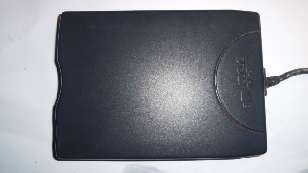
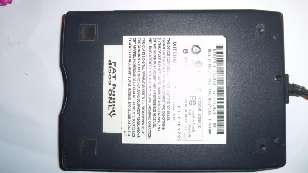
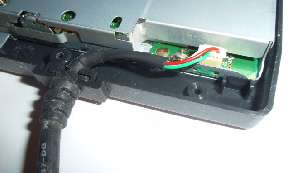
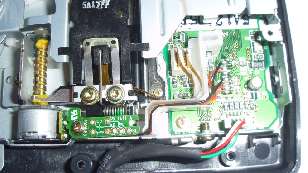

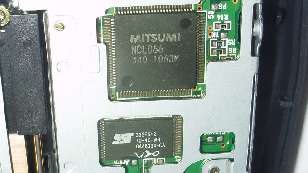
This is why it is extremely interesting to see William discussing his floppy drive interface on the ROOL forum. Details are not known, but from the description it would appear to be a PIC that can talk USB which interfaces directly with a 1772 floppy disc controller (as used in the later BBC Micro, the A310, the A3000, etc). The code running in the PIC will be doing something fairly similar to the USB floppy drive (only there the controller chip contains the low level floppy interface (the 1772) within itself). The difference? It won't be hardwired to FAT.
I hope William's project is sufficiently open-minded that it is capable of reading 256 byte sectors as well. This could give access to Econet FileStore discs (spec here) as well as Beeb/Electron/Master (ADFS S and M format) discs as well. Of course, additional software may be required to actually understand such formats, however the biggest hurdle at the moment is getting anything at all to recognise that non-FAT floppies exist... I'm going to keep my eye on this project.
Rob, 7th March 2017, 20:21
William's floppy drive sounds interesting and useful! I've not really got a use for one on RISCOS, but it would go a long way towards accessing and archiving old discs on a PC under Windows, esp. if it would talk to 5.25" drives too...jpa, 13th January 2018, 21:17
https://eu.mouser.com/ProductDetail/Microchip-Technology/SST39SF 512-70-4C-NHE/?qs=HXayfqKFfDV8l9oNgilf9w==
https://jpa.kapsi.fi/s tuff/other/SST39SF512.pdf
It could be interesting to dump the contents of the flash chip. The main CPU is probably 8051-based design. Of course designing any alternate firmware for it would be an enormous task.Rick, 13th January 2018, 22:00
Interesting it is a Flash, I wonder if the drive has any self update capability?Stephan Sokolow, 19th June 2021, 20:30
(i.e. A USB device which, driven by custom host-side software, reads raw flux transitions off the drive and then converts them to your desired disk image format in software.)
All three of those I listed are available for Linux with the first two being open hardware with open-source client software.
| © 2017 Rick Murray |
This web page is licenced for your personal, private, non-commercial use only. No automated processing by advertising systems is permitted. RIPA notice: No consent is given for interception of page transmission. |